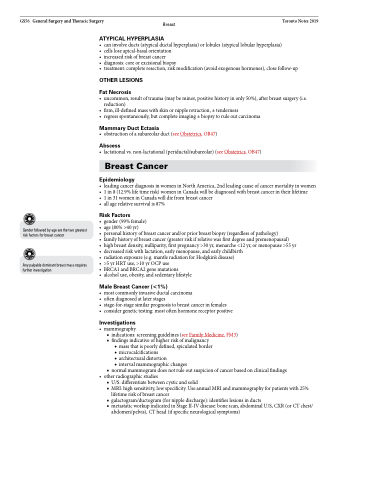Page 458 - TNFlipTest
P. 458
GS56 General Surgery and Thoracic Surgery Breast Toronto Notes 2019
Gender followed by age are the two greatest risk factors for breast cancer
Any palpable dominant breast mass requires further investigation
ATYPICAL HYPERPLASIA
• caninvolveducts(atypicalductalhyperplasia)orlobules(atypicallobularhyperplasia) • cellsloseapical-basalorientation
• increasedriskofbreastcancer
• diagnosis:coreorexcisionalbiopsy
• treatment:completeresection,riskmodification(avoidexogenoushormones),closefollow-up
OTHER LESIONS
Fat Necrosis
• uncommon,resultoftrauma(maybeminor,positivehistoryinonly50%),afterbreastsurgery(i.e. reduction)
• firm,ill-definedmasswithskinornippleretraction,±tenderness
• regressspontaneously,butcompleteimaging±biopsytoruleoutcarcinoma
Mammary Duct Ectasia
• obstructionofasubareolarduct(seeObstetrics,OB47) Abscess
• lactationalvs.non-lactational(periductal/subareolar)(seeObstetrics,OB47) Breast Cancer
Epidemiology
• leadingcancerdiagnosisinwomeninNorthAmerica,2ndleadingcauseofcancermortalityinwomen • 1in8(12.9%lifetimerisk)womeninCanadawillbediagnosedwithbreastcancerintheirlifetime
• 1in31womeninCanadawilldiefrombreastcancer
• allagerelativesurvivalis87%
Risk Factors
• gender(99%female)
• age(80%>40yr)
• personalhistoryofbreastcancerand/orpriorbreastbiopsy(regardlessofpathology)
• familyhistoryofbreastcancer(greaterriskifrelativewasfirstdegreeandpremenopausal)
• highbreastdensity,nulliparity,firstpregnancy>30yr,menarche<12yr,ormenopause>55yr • decreasedriskwithlactation,earlymenopause,andearlychildbirth
• radiationexposure(e.g.mantleradiationforHodgkin’sdisease)
• >5yrHRTuse,>10yrOCPuse
• BRCA1andBRCA2genemutations
• alcoholuse,obesity,andsedentarylifestyle
Male Breast Cancer (<1%)
• mostcommonlyinvasiveductalcarcinoma
• oftendiagnosedatlaterstages
• stage-for-stagesimilarprognosistobreastcancerinfemales
• considergenetictesting:mostoftenhormonereceptorpositive
Investigations
• mammography
■ indications: screening guidelines (see Family Medicine, FM3) ■ findings indicative of higher risk of malignancy
◆ mass that is poorly defined, spiculated border ◆ microcalcifications
◆ architectural distortion
◆ interval mammographic changes
■ normal mammogram does not rule out suspicion of cancer based on clinical findings • otherradiographicstudies
■ U/S: differentiate between cystic and solid
■ MRI: high sensitivity, low specificity. Use annual MRI and mammography for patients with 25%
lifetime risk of breast cancer
■ galactogram/ductogram (for nipple discharge): identifies lesions in ducts
■ metastatic workup indicated in Stage II-IV disease: bone scan, abdominal U/S, CXR (or CT chest/
abdomen/pelvis), CT head (if specific neurological symptoms)


